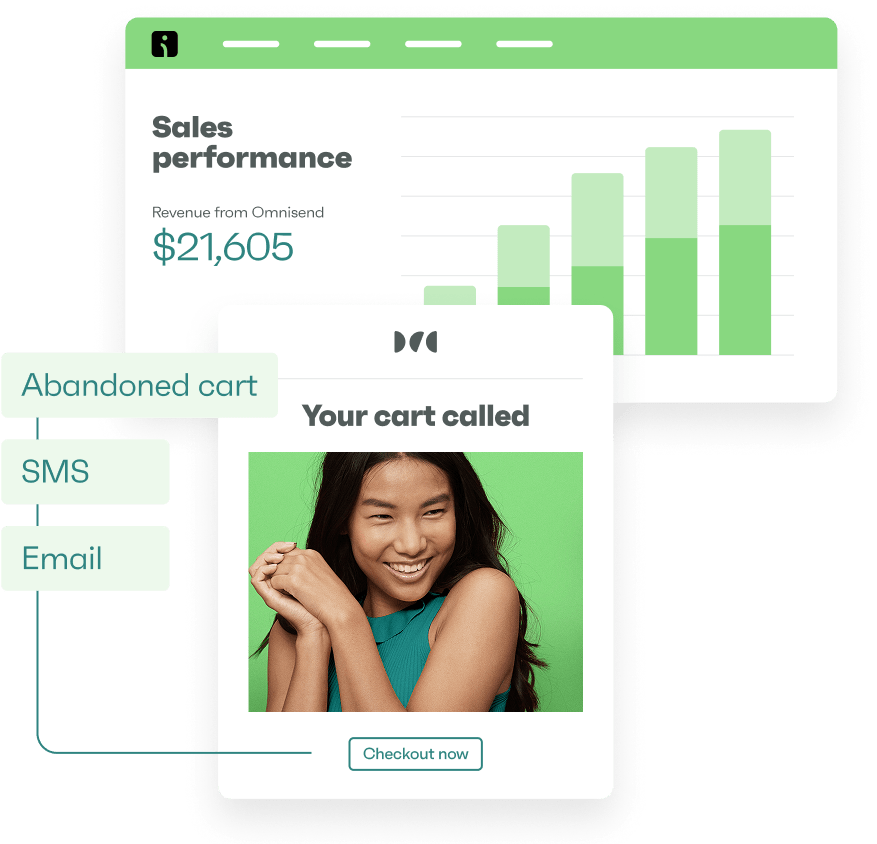Drive sales on autopilot with ecommerce-focused features
See FeaturesThinking about launching an online store but don’t want the headache of managing stock? A T-shirt dropshipping business could be your ideal starting point. In this guide, we’ll walk you through how to create a made-to-order, branded T-shirt store using print-on-demand (POD) suppliers — so you can start selling without the hassle of inventory.
Unlike traditional dropshipping, where you might sell generic items from bulk suppliers, this model lets you build your own brand. Each T-shirt is printed and shipped only after a customer places an order, giving you more creative control and lowering your overheads.
All you need is the right products, reliable suppliers, a professional storefront, and marketing that attracts customers to your store.
Join us below to learn how to dropship T-shirts and start a thriving business in 2025. We’ll cover the first steps, marketing strategy, and mistakes to avoid. Plus, we’ll point you toward print-on-demand (POD) suppliers that are worth your time.
Quick sign up | No credit card required
New to dropshipping? Read these articles:
Top 20 Shopify dropshipping stores to learn from in 2025
12 dropshipping marketing strategies and tips for 2025
How to start dropshipping: 7 key steps for beginners (2025)
How to start a T-shirt dropshipping business?
You need six things to start a dropshipping T-shirt business:
- A niche and brand identity
- Product designs
- A storefront
- A POD supplier
- Email marketing setup
- A launch strategy
Let’s explore each of these in more detail.
1. Choose a niche and define your brand
Pick one category instead of selling everything to everyone because you’ll compete against millions of generic T-shirt stores.
For instance, “funny shirts” puts you against established sellers with massive budgets and customer bases already locked in. “Hiking dad humor” or “veterinary technician pride” are small but underserved niches with great potential.
Google Trends shows search volume patterns over the past year for any keyword you enter into the search bar. It also reveals related queries — a search for “T-shirt” reveals the following:
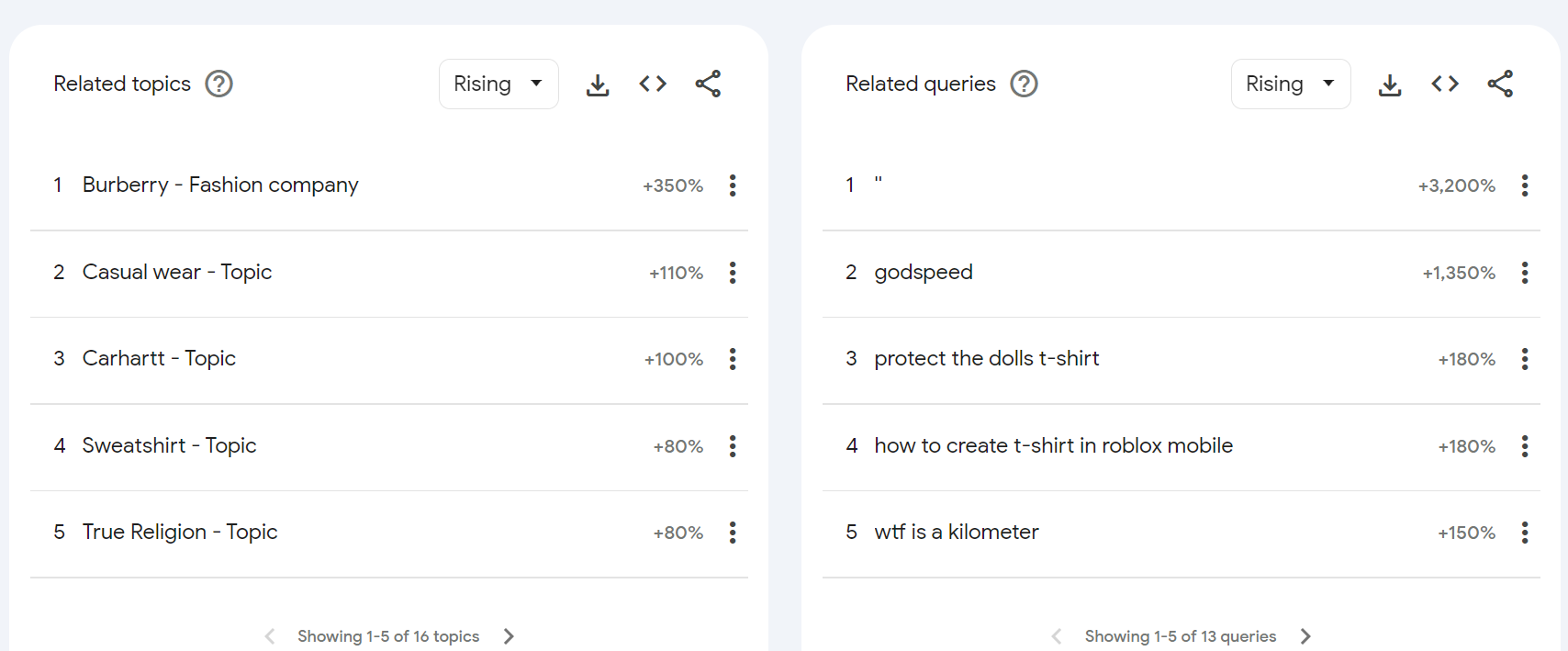
Build a buyer persona after confirming that people are searching for your niche products because you need to know who buys your shirts. Age, income, hobbies, and shopping habits determine everything from design choices to marketing copy that converts visitors into paying customers.
2. Design your products
Create designs using Canva, Photoshop, or free alternatives like GIMP if you have basic graphic skills and want to keep costs low. Outsource to Fiverr or 99designs when you need professional results but lack design experience or time to learn the software.
Here are a few tips for the design stage:
- Text weights: Bold text works because people can read it from far away. Scripts look messy when printed on fabric unless they are huge, so stick with simple typefaces.
- Graphics positioning: Center your main design or place smaller graphics on the left chest like a logo. Clean lines beat cluttered compositions. Here’s an example from the printed T-shirt retailer Zazasy:
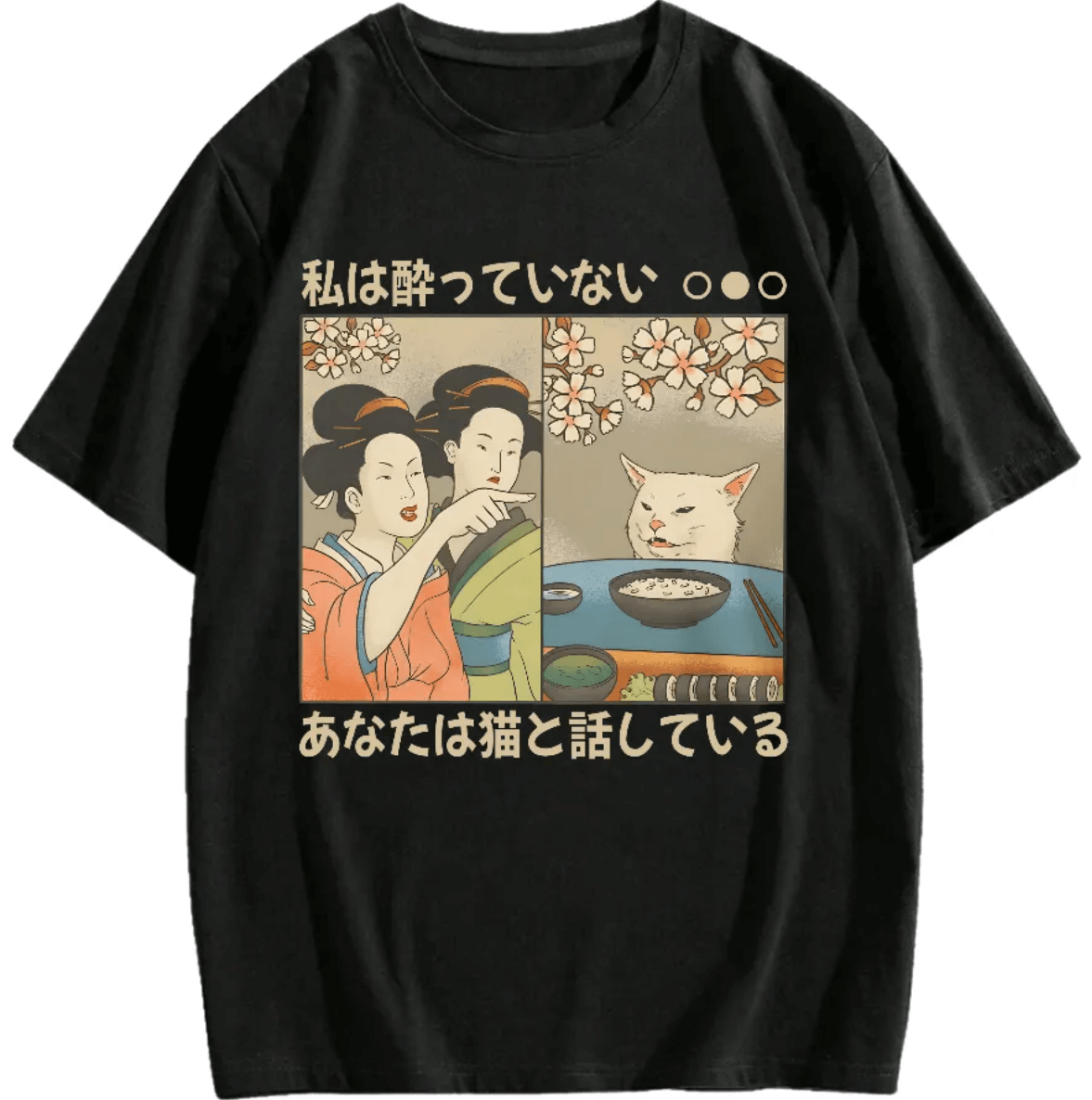
- Colors: Dark text on light shirts and light text on dark shirts create a nice contrast. Poor color choices make designs disappear or look muddy.
- Copyright and trends: Meme designs sell, but trends die fast, so move quickly. If you’re going to use any pop culture references, check the copyright first.
Additional reading:
10 Shopify T-shirt store examples (+ how to build one)
3. Set up your store
Your ecommerce platform powers your storefront and everything behind the scenes, such as payments, inventory management, and order processing.
Ideally, it’ll do all that without requiring technical expertise or development work, although you might want that flexibility for a custom and unique build.
Check out these ecommerce platforms for setting up your T-shirt dropshipping store:
- Shopify: A paid platform with monthly fees starting at $39 and includes web hosting and security, and boasts over 8,000 apps to help build your T-shirt business
- WooCommerce: Built especially for self-hosted WordPress sites, offering freedom from monthly platform fees and complete design and coding flexibility
- Wix: A drag-and-drop builder with built-in ecommerce features that are manageable for beginners but offer limited customization compared to dedicated platforms
- BigCommerce: No platform transaction fees and includes many advanced features like abandoned cart recovery without additional apps
- Ecwid: Embeds into existing websites or social media pages, and is a good option for adding ecommerce to current sites without rebuilding everything
Store inspiration — SnorgTees
Platform: Shopify
Niche: Funny T-shirts
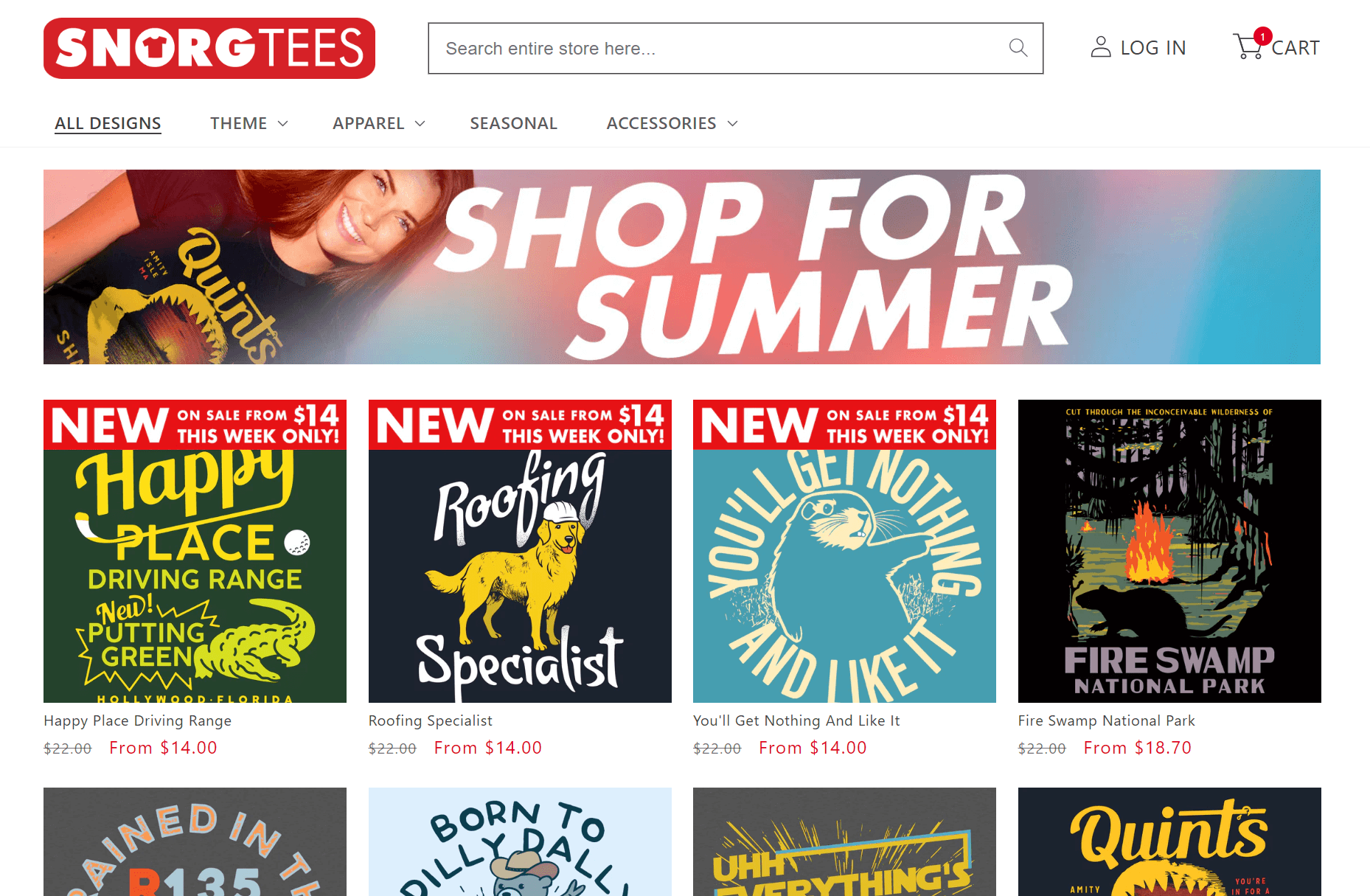
SnorgTees sells original funny T-shirts with a Shopify-built ecommerce store. Its minimalist theme uses a product grid layout, and the navigation organizes products by themes, such as dinosaurs, pop culture, and fantasy, to help customers find the perfect items.
4. Integrate with a POD supplier
Connect your store to a print-on-demand (POD) supplier that handles production, packaging, and shipping when customers place orders. Most POD platforms offer apps that automatically import their product catalog into your store without manual updates.
Your retail price minus the supplier’s base cost equals your profit per item — factor in platform fees, payment processing, and advertising costs when setting prices. A $15 retail T-shirt with a $7 supplier cost leaves $8 gross profit before other expenses eat into margins.
Reverse dropshipping is another strategy you could try — you’ll source products from Western suppliers to sell in emerging markets, such as the UAE and China.
Order samples of your products to check the print quality, fabric feel, and packaging presentation before launching to customers.
International shipping costs more than domestic delivery, so charge customers accordingly. Setting one flat shipping rate for everyone means you’ll lose money on overseas orders that cost three times more to fulfill.
Additional reading:
14 best dropshipping apps for Shopify in 2025
5. Set up email and SMS marketing
Start collecting email addresses and phone numbers before you launch. Create lead magnets like discount codes or design previews to encourage signups during your pre-launch phase.
Email automation handles customer communication without manual work once you set up the flows. Welcome series, abandoned cart reminders, and post-purchase follow-ups generate revenue automatically when customers take action in your store.
SMS marketing complements email with immediate reach and higher open rates for time-sensitive messages. Use texts for shipping updates, flash sales, and cart abandonment reminders when urgency matters more than detailed content.
Omnisend handles email and SMS marketing and supports all major ecommerce platforms, such as Shopify and WooCommerce. Here are some of its best features:
- Pre-built automation workflows for welcome series, abandoned carts, post-purchase follow-ups, and re-engagement:
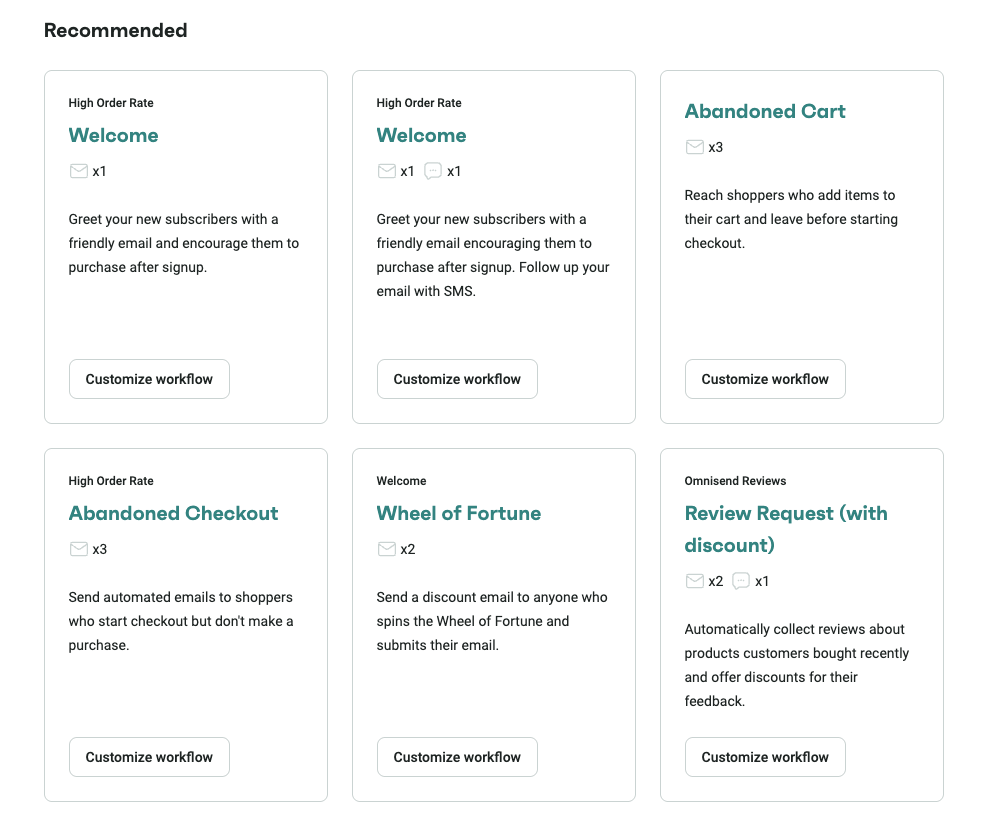
- Combine email, SMS, and push notifications in all automation flows
- Customer segmentation based on purchase history, location, and engagement levels
- Popup forms and signup tools to grow your email list before launch
- Bulk-sending tools for promotional campaigns
- Free plan available with access to all standard features, unlimited push notifications, and 500 emails/month
Watch this video to discover the best automations for dropshipping in 2025:
6. Launch and promote
Start with organic promotion and early email campaigns to generate initial sales without spending money on ads. Focus on channels where your target customers already spend time and engage authentically. Here are some best practices:
Organic promotion
- Post product mockups on Instagram and TikTok with niche hashtags that your target customers follow
- Join relevant Reddit communities and Facebook groups without spamming and contribute valuable content before mentioning your products
Product reviews
- Send free samples to customers in exchange for honest reviews on your store and social media platforms
- Request reviews a few days after delivery to give your testers time to inspect and wear your T-shirt and formulate opinions
Influencer outreach
- Gift T-shirts to micro-influencers in your niche who have engaged audiences rather than large follower counts
- Ask for user-generated content posts in exchange for free products instead of paying cash upfront
Email and SMS campaigns
- Use Omnisend to send early-bird discount offers to subscribers who signed up during your pre-launch phase
- A/B test different subject lines for your launch announcement email to optimize open rates and conversions
Discover more marketing ideas:
12 dropshipping marketing strategies & tips for 2025
How to choose the right T-shirt dropshipping supplier?
Selecting the right supplier affects everything from product quality to customer satisfaction and profit margins. Follow these best practices to narrow down your choices:
Product quality and printing types
Different printing methods produce vastly different results for your designs.
Direct-to-garment (DTG) works best for detailed artwork and small orders, screen printing delivers vibrant colors for simple designs at scale, sublimation creates all-over prints on polyester fabrics, and embroidery adds premium appeal to logos and text.
Order samples from potential suppliers to test print quality, fabric feel, and durability before committing to any partnership.
Shipping locations and delivery times
Local fulfillment centers reduce shipping times compared to overseas suppliers. US-based fulfillment reaches American customers in three to five days, EU centers serve European markets quickly, and global networks offer regional shipping advantages.
Customers expect Amazon-level delivery speeds, so slow international shipping (two to six weeks) hurts reviews, repeat purchases, and brand perception. Verify turnaround times during peak seasons when delays are most likely.
Pop culture T-shirt retailer m00nshot states its tees are printed and shipped from the USA on product pages to alleviate concerns over slow shipping times:
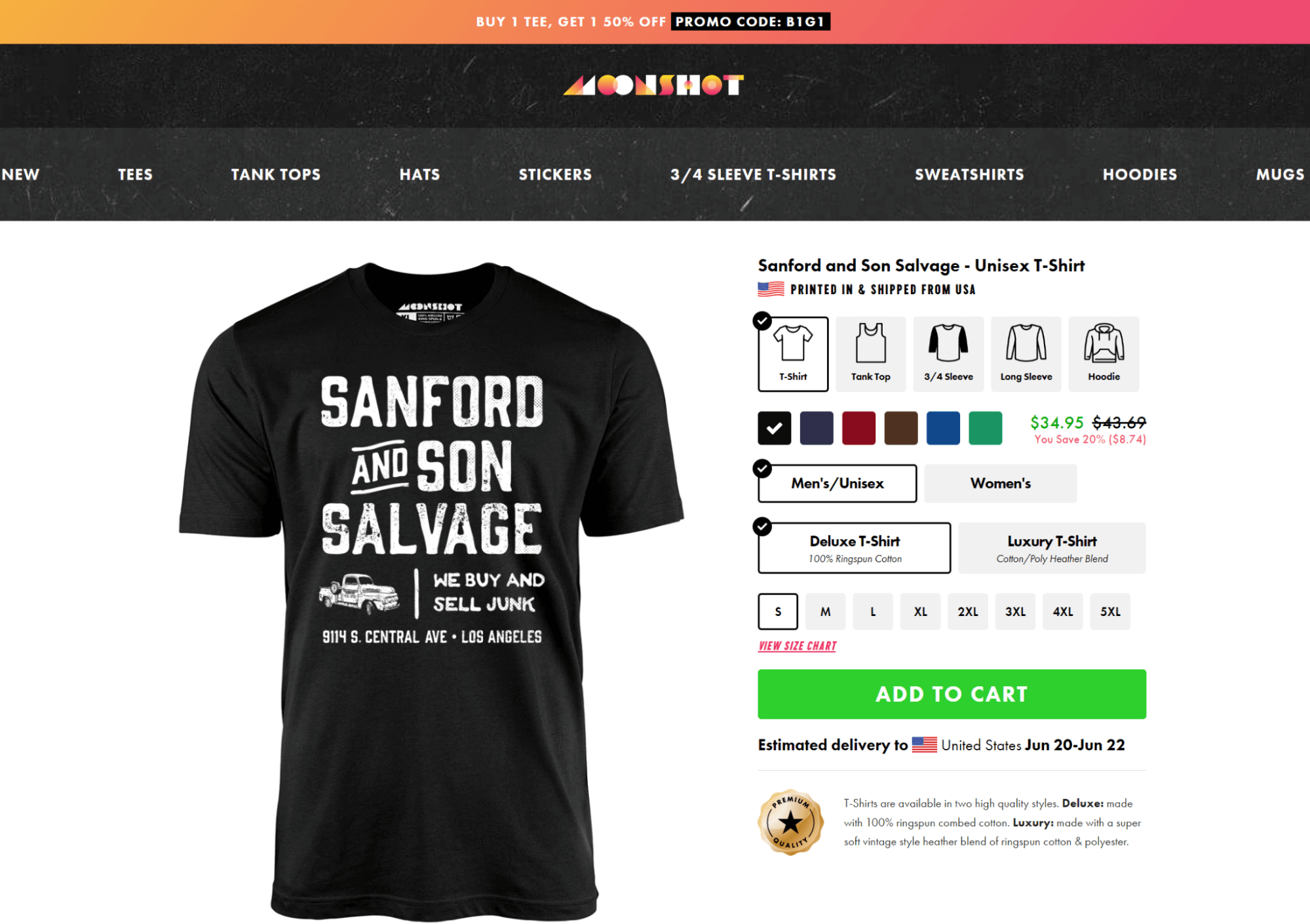
Integrations and ease of setup
Platform integration saves hours of manual work and reduces order errors. Confirm that your chosen supplier offers native apps for Shopify, WooCommerce, or your preferred ecommerce platform.
Look for automated dropshipping, real-time inventory updates, and order routing that forwards customer details without manual intervention. Poor integrations create fulfillment headaches that scale with your business growth.
Pricing structure and margins
Base product prices don’t tell the complete cost story. For instance, Printify Premium offers discounts but charges monthly fees, pay-per-product models have no upfront costs but higher per-item rates, and shipping fees vary by location and speed.
Here’s an example of Printify’s plan pricing:
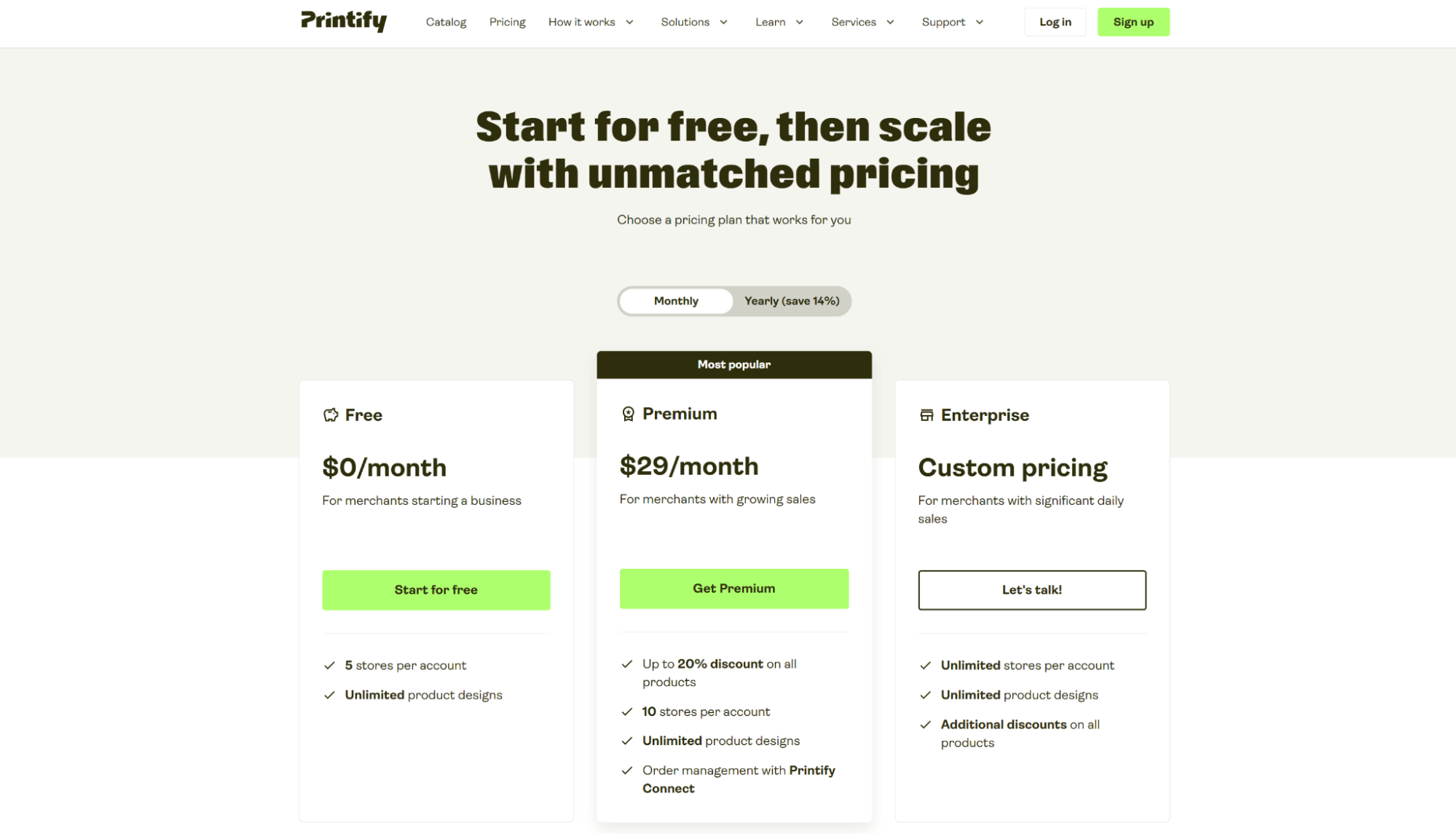
Calculate total fulfillment costs, including platform fees, payment processing, and advertising, when setting retail prices. Aim for a 100% markup as your baseline and adjust based on market testing and competition.
Branding options and packaging
Custom neck labels, branded packaging, and hang tags separate professional brands from generic dropshippers. Some suppliers offer basic white-label fulfillment, but premium branding features often cost extra or require minimum order volumes.
Even something as simple as a branded packing slip with your logo can differentiate your T-shirt business. POD supplier Printful offers such a service:
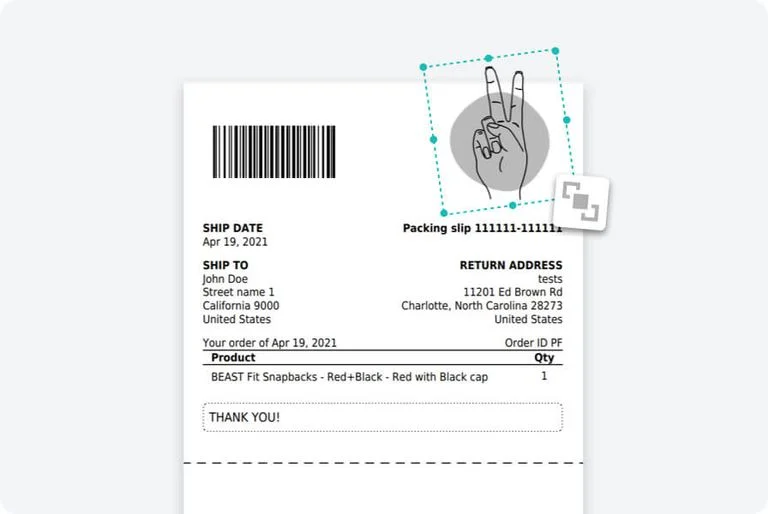
Evaluate which customization options align with your brand positioning and budget constraints before choosing suppliers based solely on product selection.
Customer support and reliability
Supplier support quality is critical during peak seasons, product issues, or order problems. Test response times with pre-sales questions, check available support channels (email, chat, phone), and read community reviews on Reddit, Facebook groups, and Trustpilot.
Unreliable suppliers can create customer service nightmares that damage your brand reputation even when problems aren’t your fault.
5 best T-shirt dropshipping companies
Check out these suppliers to dropship clothing and T-shirts:
1. Printful
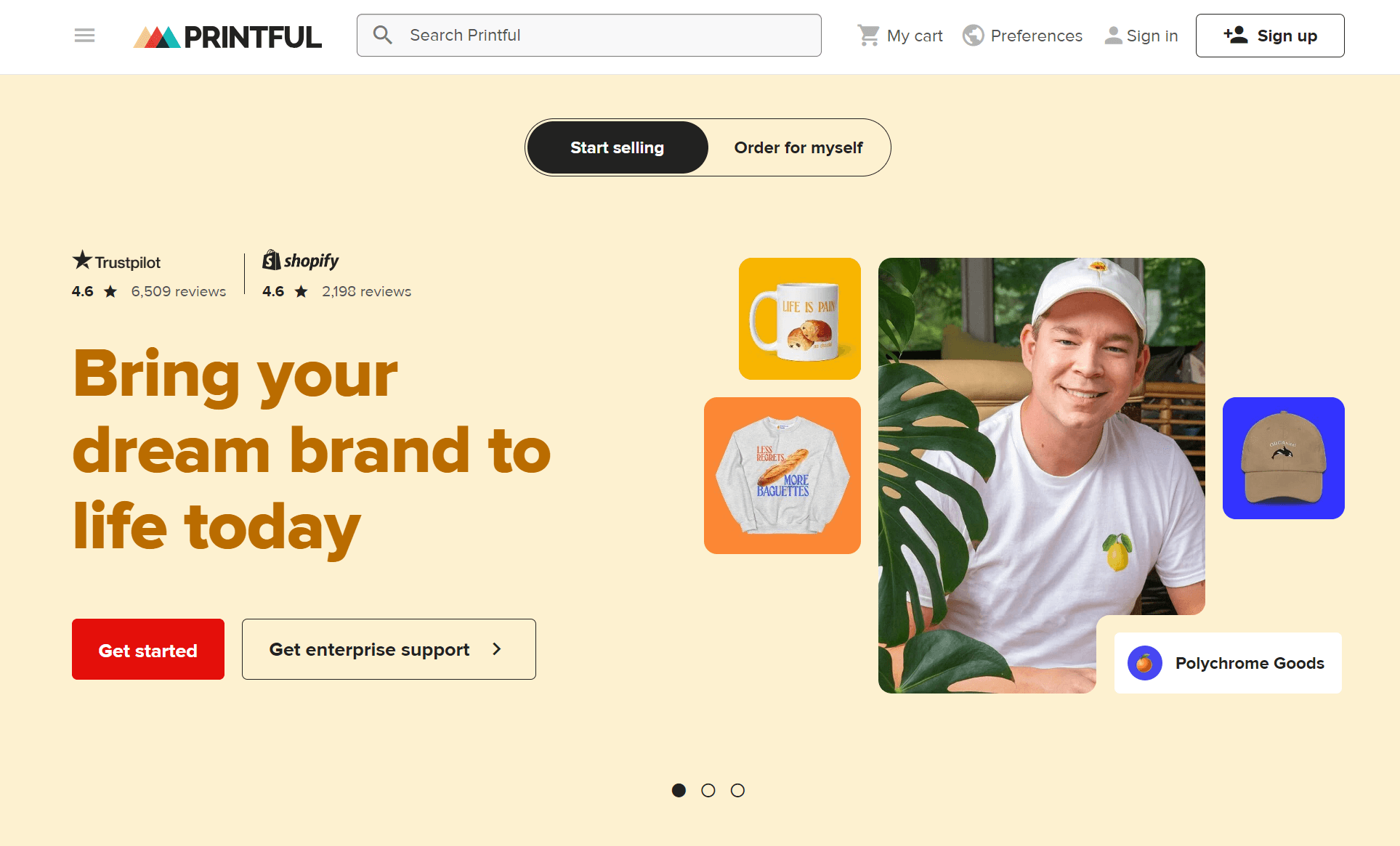
Printful handles the production, fulfillment, and shipping of POD orders from dedicated facilities rather than outsourcing to third-party providers. It focuses on premium product quality and faster turnaround times.
Pricing
- Free plan with pay-per-order model
- Growth plan from $24.99/month with up to 33% off custom premium products
Shipping
- US shipping from $4.75
- Bulk order discounts for 25+ units
Key features
- 410+ premium products
- White-label packaging with custom branding
- Design Maker and mockup generator tools
- DTG, embroidery, AOP, and DTF printing options
- 24/7 customer support
Reviews
- Shopify 4.6/5 (based on 2,200+ reviews)
- Trustpilot 4.6/5 (based on 6,500+ reviews)
| Feature | Details |
|---|---|
| Printing methods | DTG, embroidery, AOP, DTF |
| Fulfillment speed | Two to five business days |
| Integrations | Shopify, Etsy, WooCommerce, BigCommerce, Amazon |
| Base T-shirt cost | From $8.75 |
| Mockup tools | Design Maker, mockup generator |
| Branding options | Custom labels, white-label packaging, pack-ins |
| Ships from | US, Europe, global fulfillment centers |
| Best for | Quality-focused brands, premium positioning |
2. Printify

Printify connects your store to a network of print providers who handle the production and shipping of your T-shirts. It has apps for Shopify, WooCommerce, and Wix, and its marketplace lets you compare prices and quality across different suppliers.
Pricing
- Free plan available for up to five stores
- Premium at $29/month with up to 20% product discounts and support for 10 stores
Shipping options
- Economy from $3.99
- Standard from $4.75
- Express $7.99
- Priority calculated individually
Key features
- 1,300+ customizable products
- Multiple print provider choices
- Automated order routing
- Mockup generator
- Customizable branding
Reviews
- Shopify 4.7/5 (based on 2,400+ reviews)
- Trustpilot 4.7/5 (based on 5,800+ reviews)
| Feature | Details |
|---|---|
| Printing methods | DTG, embroidery, sublimation, screen printing |
| Fulfillment speed | Two to seven business days |
| Integrations | Shopify, Etsy, WooCommerce, eBay, Amazon |
| Base T-shirt cost | From $6.50 |
| Mockup tools | Product creator, mockup generator |
| Branding options | Custom labels, branded packaging |
| Ships from | US, Europe, global print provider network |
| Best for | Cost-conscious sellers, testing multiple suppliers |
3. Gelato
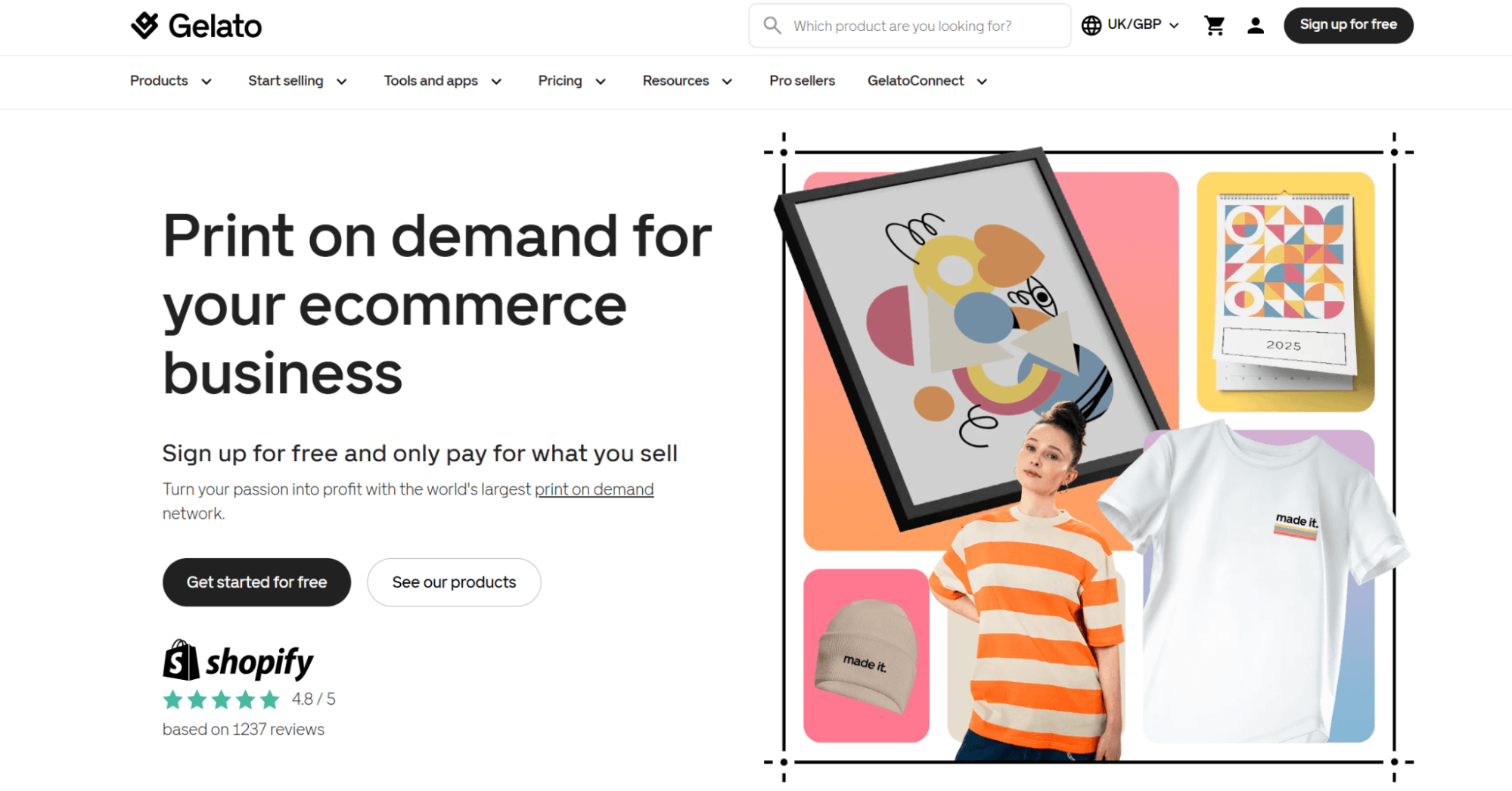
Gelato operates the world’s largest POD network with 140+ production facilities across 32 countries. Local production near customers reduces shipping times and environmental impact, which you can use as unique selling points in your T-shirt store.
Pricing
- Free plan with no monthly fees
- Gelato+ at $25/month with up to 20% product discounts
- Gold at $129/month with up to 25% product discounts
- Platinum custom pricing for enterprise
Shipping
- 90% of orders arrive within five days
- Local production minimizes shipping distances
- 60+ logistics partners globally
- Ships from the nearest available facility
Key features
- 140+ print partners in 32 countries
- 100+ million premium stock photos included
- Mockup Studio with 800+ premium templates
- Branded labels and packaging inserts
- TikTok Shop and Amazon direct integration
Reviews
- Shopify 4.7/5 (based on 510+ reviews)
- Trustpilot 4.5/5 (based on 2,300+ reviews)
| Feature | Details |
|---|---|
| Printing methods | DTG, sublimation, digital printing, offset |
| Fulfillment speed | One to three business days |
| Integrations | Shopify, Etsy, WooCommerce, TikTok Shop, Amazon |
| Base T-shirt cost | Variable by location and provider |
| Mockup tools | Mockup Studio, 800+ premium templates |
| Branding options | Custom labels, branded packaging |
| Ships from | 140+ facilities in 32 countries |
| Best for | Global brands, fast shipping, eco-conscious sellers |
4. Teemill
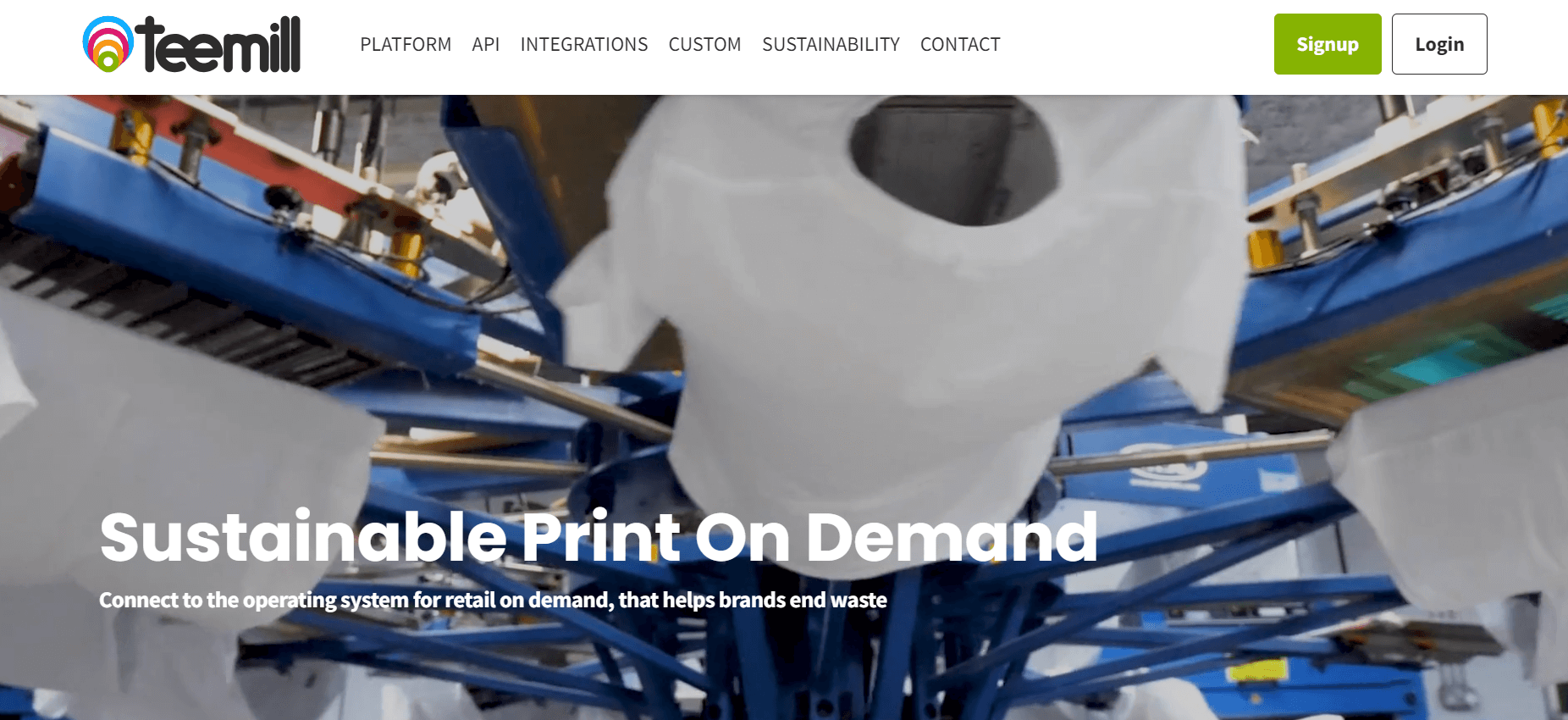
Teemill specializes in sustainable POD using organic materials (such as cotton) and renewable energy. Products are for the circular economy — customers can return worn items, which are then recycled and turned into new products.
Pricing
- Free plan with commission per order
- Pro plan from £8.25/month with advanced features
- Custom pricing for enterprise solutions
Shipping
- Same-day shipping available
- Fulfillment on the same day as orders
- Worldwide shipping with plastic-free packaging
- UK-based production facility
Key features
- GOTS-certified organic cotton products
- Circular economy design (return and remake system)
- 1,000+ pre-made designs and AI mockups
- Renewable energy-powered production
- Integrated website builder and marketing tools
Reviews
- Shopify 4.7/5 (based on 40+ reviews)
- Trustpilot 4.5/5 (based on 3,500+ reviews)
| Feature | Details |
|---|---|
| Printing methods | DTG on organic materials |
| Fulfillment speed | Same day (seconds after ordering) |
| Integrations | Shopify, Etsy, TikTok Shop, custom API |
| Base T-shirt cost | Commission-based pricing model |
| Mockup tools | AI mockup generator, 1,000+ templates |
| Branding options | Custom packaging, labels, full white-label |
| Ships from | UK facility (renewable energy powered) |
| Best for | Eco-conscious brands, sustainable positioning |
5. Apliiq

Apliiq focuses on premium branding and private labeling for clothing brands. It offers comprehensive customization services, including embroidery, patches, and complete tag replacement for professional brand presentation.
Pricing
- Free plan with pay-per-order fulfillment
- VIP plan at $29.99/month with 20% product discounts
Shipping
- Average 2.2 days shipping from distributed production
- Orders ship within five business days
- Rush production and shipping available
- Dual coast fulfillment (Los Angeles and Philadelphia)
Key features
- Complete private labeling (tag replacement, woven labels)
- Premium embroidery and patch services
- 275+ T-shirt styles, 110+ hoodies
- US-based customer support team
- Hybrid warehousing and POD options
Reviews
- Shopify 4.9/5 (based on 270+ reviews)
| Feature | Details |
|---|---|
| Printing methods | DTG, DTF, embroidery, patches |
| Fulfillment speed | Five business days (rush available) |
| Integrations | Shopify, WooCommerce, Etsy (coming soon) |
| Base T-shirt cost | Variable with VIP discounts available |
| Mockup tools | Professional mockups and design services |
| Branding options | Complete private labeling, custom tags, patches |
| Ships from | Los Angeles and Philadelphia facilities |
| Best for | Premium brands, complete customization, private labeling |
Common mistakes in T-shirt dropshipping (and how to avoid them)
It’s all too easy to rush product design, supplier decisions, and marketing strategies when learning how to start a T-shirt dropshipping business.
Making a few mishaps is perfectly normal in your first few months, but these harmful mistakes are completely avoidable when you dropship T-shirts:
Choosing generic designs
Generic clip art, overused fonts, and templated layouts flood the market because sellers think safe design choices guarantee sales. These designs perform poorly in search results and on social media because they lack a visual personality that connects with target audiences.
Here’s an example of a generic T-shirt sold on Etsy:
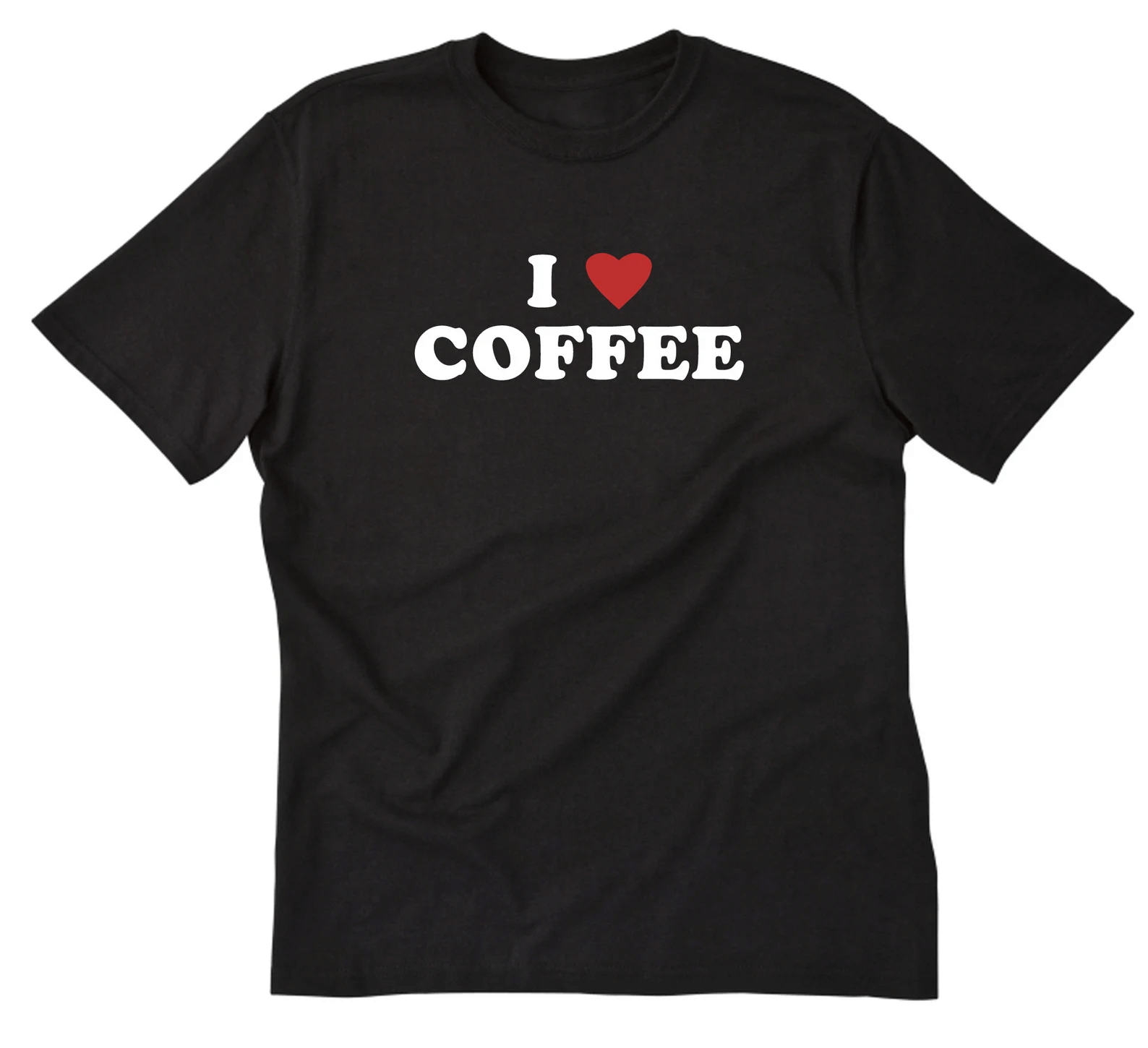
Develop a visual language tied to your niche — colors, fonts, and imagery your customers would instantly recognize as “theirs.” Unique design aesthetics build brand recognition and customer loyalty better than copying trending templates.
Not testing the supplier’s product quality
Relying on supplier mockups without ordering samples creates expensive surprises after launch. Poor print quality, stiff fabric, crooked designs, or cheap packaging generate refunds, chargebacks, and devastating one-star reviews that destroy conversion rates.
Order samples of every product variant before selling anything to customers. Test print alignment, fabric softness, color accuracy, and packaging presentation to ensure your brand reputation stays intact from day one.
Ignoring shipping expectations
Vague delivery estimates and long shipping times break customer trust faster than any other fulfillment issue. Amazon has trained customers to expect fast delivery, so two-week international shipping feels unacceptable without clear communication.
Set honest expectations on product pages with estimated delivery windows, tracking links, and shipping origin information. Transparent communication prevents disappointed customers and reduces support tickets about the order status.
For instance, True Classic Tees provides a precise shipping estimate alongside a countdown timer for priority shipping on its product page:
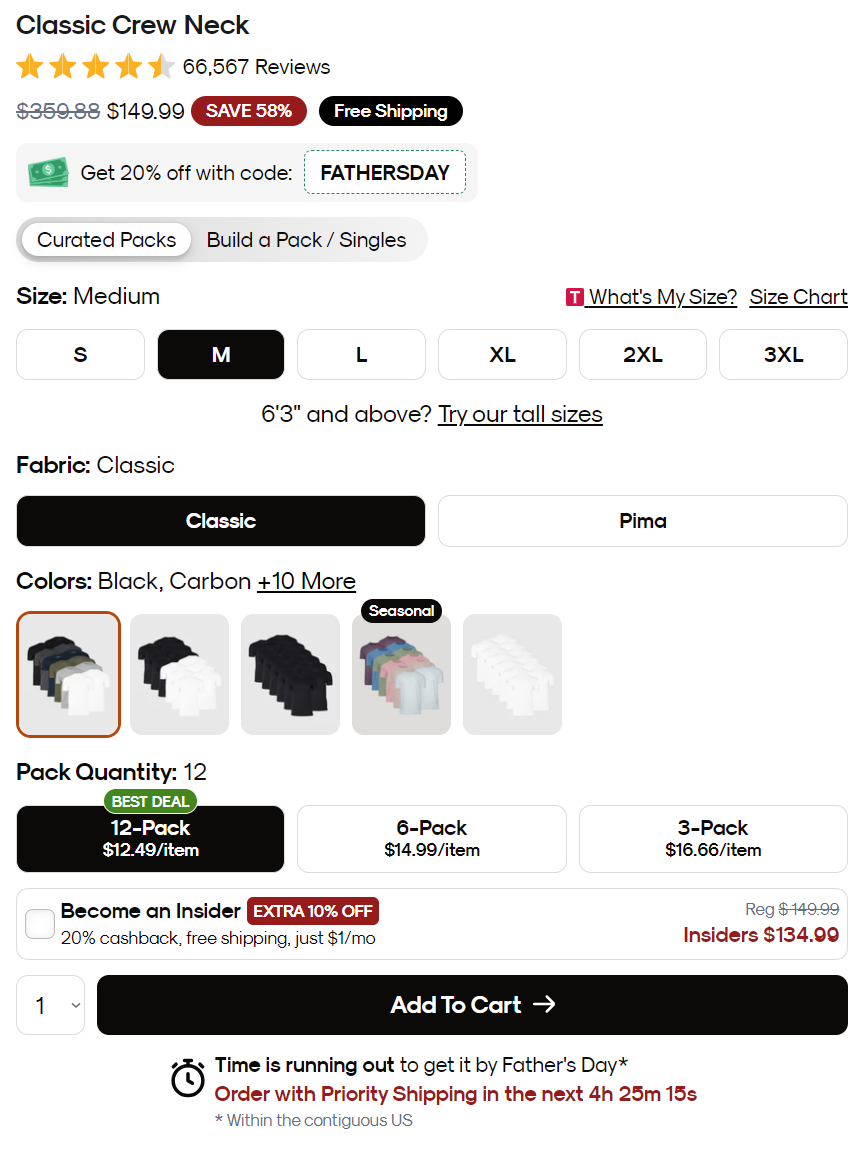
Relying on one supplier without a backup
Single-supplier dependence halts your business when fulfillment issues, product shortages, or quality problems arise. Peak seasons overwhelm suppliers, popular items go out of stock unexpectedly, and printing equipment breaks down.
Maintain relationships with at least two suppliers for your best-selling products, ideally from different regions or networks. Backup suppliers keep revenue flowing when primary partners experience delays or capacity issues.
Neglecting email and SMS post-purchase flows
You can increase customer lifetime value, and average order value with post-purchase email and SMS flows that bring customers back.
Omnisend’s automation sends post-purchase review requests, cross-sell offers, and retention campaigns that turn one-time buyers into repeat customers. Automated flows generate revenue without additional advertising costs and improve customer relationships over time.
How to stand out in a saturated market?
Most T-shirt dropshipping stores look identical, with generic designs, stock photos, and bland messaging. You can stand out with deliberate choices that separate your brand from thousands of competitors using the same suppliers and templates.
Build a brand, not a product page
Create a cohesive brand identity with a memorable logo, consistent tone of voice, and professional packaging inserts.
Write an authentic “About” page that tells your story instead of generic company descriptions. Avoid default store themes and bland product titles like “Funny Cat Shirt” — use descriptive names that reflect your brand personality and speak directly to your audience.
Use original product photography
Printful and Printify mockups work for testing products, but every competitor can access these identical images and sell them online.
Tools like Placeit can generate branded mockups quickly, or you can invest in lifestyle photography with friends as models wearing your designs in real environments.
User-generated content from customers creates authentic social proof that converts better than sterile product shots. Consider adding Instagram feeds to your site for syndication.
Nurture customer loyalty with personalization
Retention starts with relevant communication based on customer behavior rather than generic newsletters sent to everyone.
Omnisend lets you segment customers and automate targeted email and SMS flows triggered by product views, abandoned carts, and purchase history.
Email segmentation increases engagement rates compared to broad messaging that ignores individual preferences and shopping patterns.
Lean into niche content
Build a content ecosystem around your niche with articles, newsletters, and social media posts that educate and entertain your audience.
Share industry and brand news, tips, best practices, style guides, and stories that matter to your customers beyond just promoting products. The consistent publication of high-quality content keeps your brand visible when customers are ready to buy.
T-shirt dropshipping FAQs
It can be — most sellers earn 40-60% gross margins before advertising expenses eat into profits. You can become more profitable with a customer retention strategy and upsells, both of which maximize the value of each customer you attract.
It’s possible with the right niche and marketing, but most beginners earn $100-500 monthly in their first year. Building to $10k requires consistent testing, scaling, and customer retention.
Printify offers lower base costs and up to 20% discounts with its $29/month Premium plan. Printful charges more per item but doesn’t require monthly subscriptions for basic features.
Most new dropshippers earn $0-200 in their first few months due to learning curves and testing costs. Successful beginners who stick with it reach $500-1,000 monthly after six or so months.
TABLE OF CONTENTS
TABLE OF CONTENTS


No fluff, no spam, no corporate filler. Just a friendly letter, twice a month.

 OFFER
OFFER







